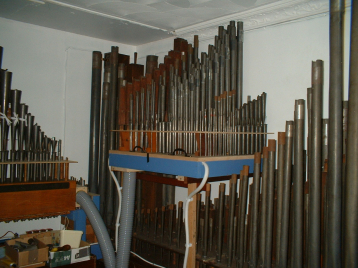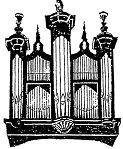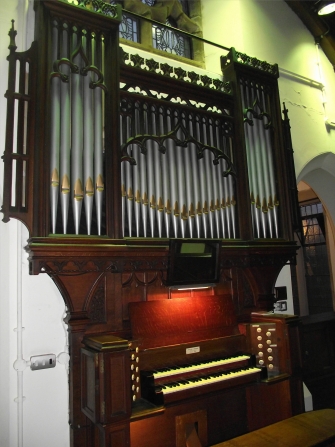
In-House House Organ
A few years ago now, I and my colleague Patrick Flynn were invited to overhaul a small instrument in a former convent, Ensleigh, in the Beverley Road, Hull.
The instrument was built in 1909 by the local firm Forster and Andrews, by that time under the management of Philip Selfe. I was very impressed with those parts of it that still played, and by the beautifully made solid oak case. Much of the Great was 'off' and even more of the Swell did not play. Tonally it was a child of its time, but all perfectly voiced and blended. The specification stood:
GREAT
Open Diapason 8
Stopped Diapason 8
Dulciana 8
Principal 4
SWELL
Hohl Flute 8
Gamba 8
Voix Celeste 8
Harmonic Flute 4
Horn 8
PEDAL
Bourdon 16
It was blessed with a full array of octave and suboctave couplers, all working (or by this time not working) on penumatic action.
I fully expected our work to be that of cleaning everything, repairing worn leather and perhaps a few lengths of crushed pneumatic tube. However, as soon as we got the organ stripped down, it became clear that these were not the problems. There was a little bell on the roof just outside and the rope passed through the organ area, it had originally been made to run through a metal conduit, but this had rusted away. Essentially, rainwater had been trickling down the bell-rope and into the organ, right above the touch-box - the 'brains' of a pneumatic action. In 1909 organ-builders all used one glue - Scotch Glue, which is made from horses' hooves. It's great, but soluble in rainwater. The pneumatic touch box had in some places set solid, I had to go back to our sponsor (a long-term friend, delightful getleman by the name of Wilf Jones, by that time he was nearly 90 years old) and tell him there were two choices: We could put the instrument back together and leave it unplayable (at no cost) or we could electrify it, replacing all the key pneumatics with new lever magnets (at something like £15 each!). He took barely five minutes to decide that he would pay the extra cost, the level of sponsorship required had literally doubled. In addition to the magnets, I had to provide suitable keyboards and pedalboard to drive them, electrify the console controls and make new switching. While I was at it, I added two small extras to the scheme, viz a Pedal Bass Flute 8 extension and a Great Octave coupler (which turned out to be an enormous bonus).
Happy ending: Following our work on the organ, Wilf was able to play it virtually every week for the rest of his life, the senior nun who was running the place as a conference centre was able to hold her jubilee celebration in the chapel with the musical support of a fully-playable organ (and with me as guest organist), we even held a special birthday party for Wilf's 90th there. The local organists' association visited and gave it their blessing etc., etc.
Roll on a few years and we heard that the whole place was to be sold and turned into flats! Patrick wrote to the trustees and asked if we might be allowed to remove and rehouse the organ. A small team of friends helped me remove it and store it safely.
We offered the instrument to a friend who was then organist at Drax as a possible replacement for his small one-manual. He'd seen this one and liked it while it was up and playing, but in the event, authorities decided that it wasn't big enough! I was left with a splendid little instrument - all in parts, the larger ones stacked in a large heap in my hallway. The penny dropped: remarkably, the case would fit, and just by my music room (I live in a c. 1995 bungalow) was a spare room that had been my wife's office, it would make an organ chamber!
The decision was an easy one - I decided to install Ensleigh's and Wilf's organ here, to keep the F&A material as far as possible unchanged, regarding pressure, chests etc. but use the extra space in my chamber to add some extension ranks. I have the incomplete barn organ, of course, which (even if only partly complete) remains a great deal of fun to play but the idea of a smaller scheme for a really good practice organ in the warm really appealed to me.
MY SCHEME:
House Organ (for Keys House, Ings Lane, Keyingham, Hull) as updated 20.7.22
All pipework to be enclosed in an adjacent room, shutters in the wall to Music Room. Detached stopkey console (in oak) on mobile platform, swell controls via Bowden cables.
Great (16 stopkeys)
16 Lieblich Bourdon (small additional pallet version of Bourdon plus extension of Rank D)
16 Contra Dulciana (nos.1-12 electronic 13-24 shared with Dulciana, remainder on second extension soundboard)
8 Open Diapason* (bottom octave in wooden pipes)
8 Rohr Flute*
8 Dulciana*
4 Principal*
4 Gedeckt Flute Ext.D
2.2/3 Twelfth Ext.H
2 Gemshorn Ext.C
1.3/5 Tierce Ext.B
8 Trumpet Ext.F
Great Octave
Swell to Great [NB Swell Octave plays through]
Choir to Great [NB Choir Octave plays through]
Solo to Great
Tremulant (to Great and Choir)
Swell (16 stopkeys) (in its own Swell box)
16 Contra Salicional (1-12 Electronic, 13-32 from Viola da Gamba, remainder from Unit A')
8 Claribel Flute*
8 Viola de Gamba*
8 Voix Celeste*
4 Harmonic Flute*
4 Salicet Ext.A
2 Fifteenth Ext.A
II Sub Cornet (5.10) (three straight octaves with breaks/repeats both ends)
III Mixture (22.26.29) (three straight octaves with breaks/repeats both ends)
16 Bassoon (unit E, Bevington Fagotto, bottom octave electronic)
8 Horn*
8 Oon Ext.E
4 Trebloon Ext.E
Swell octave
Solo to Swell [NB also affected by Swell Octave]
Tremulant (Swell only)
Choir (12 stopkeys)
8 Gedackt Ext.D
8 Gemshorn (bottom octave shared with Great Diapason) Ext.C
8 Gemshorn Celeste Ext.B (tuned flat to provide correct Tierce above)
4 Open Flute Ext.G (1-12 from D)
4 Octave Gemshorn Ext.C
2.2/3 Nazard Ext.D
2 Block Flute Ext.D
1.3/5 Tierce Ext.B
1.1/3 Nineteenth Ext.H (breaks back at top)
Choir Octave
Swell to Choir [NB Swell Octave plays through]
Solo to Choir
Solo (3 stopkeys)
8 Open Flute Ext.G (basses from D)
8 Clarinet Unit chest
8 Trumpet Ext.F
Pedal (15 stopkeys)
32 Harmonic Bass Ext.D
16 Bourdon Ext.G
16 Lieblich Bourdon Ext.D (1-12 use smaller pallets on rank G)
8 Principal (shares Diapason Bass) then Ext.C
8 Bass Flute Ext.D
4 Octave Ext.C
4 Octave Flute Ext.D
IV Pedal Cornet (derived from ranks D and C)
16 Double Trumpet Ext.F
Solo to Pedal
Solo Octave to Pedal
Swell to Pedal [Octave coupler does not play through]
Great to Pedal [Octave Coupler does not play through]
Choir to Pedal [Octave coupler does not play through]
Great and Pedal Combinations Coupled
Four Manuals CC-c 61notes
Pedals CCC-G 32 notes
Two slider soundboards with original 1909 Forster and Andrews pipework (marked * above)
Four units inside extended Swellbox, viz Bassoon 8', Salicional 4', Sub Cornet II and Mixture III
Three units on ex-Tiverton soundboard, viz Gemshorn, Gedackt and Twelfth
Four units on second unit soundboard, viz Gemshorn Celeste, Dulciana Treble, Clarinet and Open Flute from 4'
Two Small Soundboards for Trumpet 8' and 16' Trumpet Octave
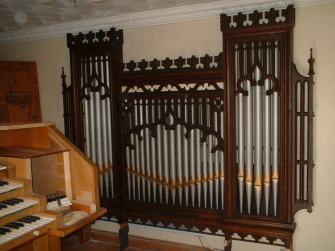
Current status:
As of today (25/10/22) all nine manual stops rescued from Ensleigh play and some couplers.
See above a photo of the case as installed. Behind it is an opening in the wall, covered by five (Binns) swell-shutters.
I'm still waiting for some stopkeys to complete the console. Both jambs will be full of ex-Walker stopkeys, four tiers each side.
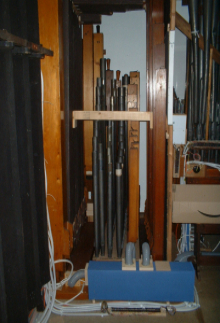
(Nov/Dec)
Recent additions are some Gamba basses, a 73 note Bassoon rank and the top 2/3 of a Solo Trumpet, made more than 100 years ago by Norman & Beard, rescued about a year ago from a long defunct instrument in Teesside.
20.12.22
A few days ago, Patrick Flynn and I made some little (very quick) recordings to help illustrate the progress of this instrument. The first video below is an extract from a John Stanley Vountary in D to demonstrate the style of the Solo Trumpet, the Swell Horn and Great Stopped Diapason and Principal.
The Second extract is from La Cinquantaine by Gabriel-Marie, it demonstrates the Great Stopped Diapason on its own and the Swell strings (NB there is not yet a swell enclosure inside the chamber, eventually there will be one).
The last two video clips are of a slow pan around the music room and organ chamber so you can get an idea of what stage this project has reached. Also to be seen are tools and organ bits awaiting insrtallation later. I think a snow-covered garden is visible at some point too.
All four extracts have been crudely trimmed so as to get them small enough to upload within the limit permitted here. Better than nothing, I hope.
September 25th 2023
More photos, lots more organ is in and playing.
